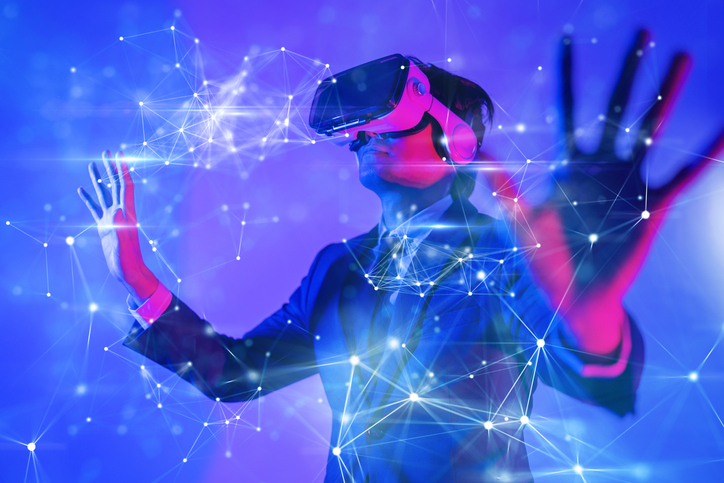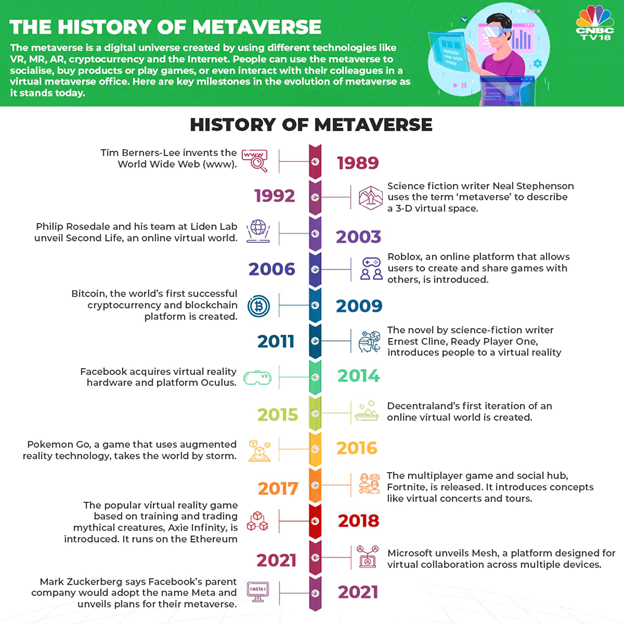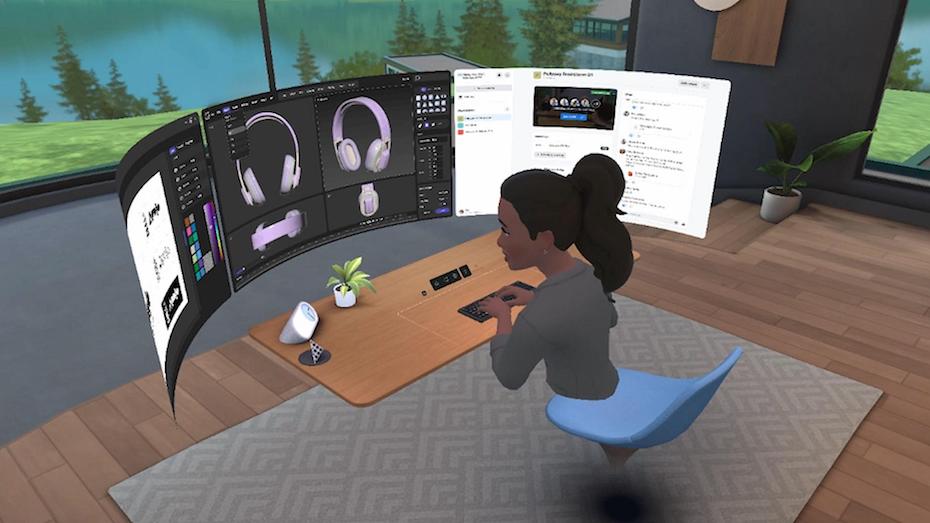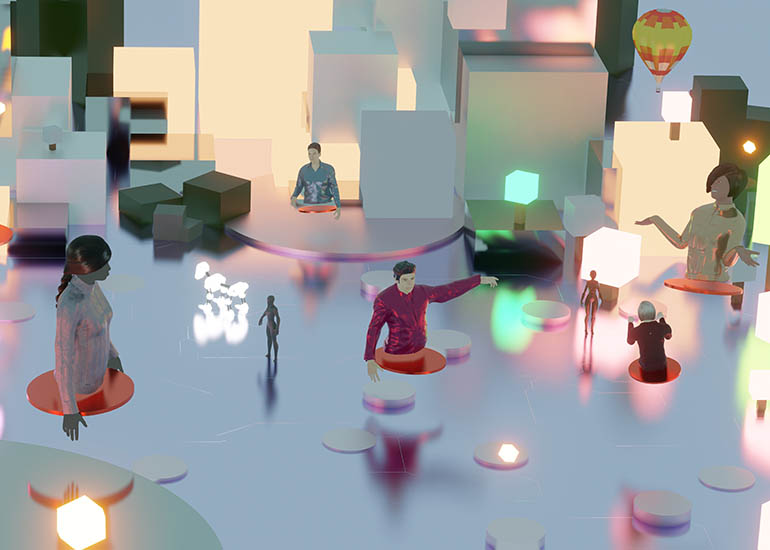How remote work will change due to the Metaverse
Published

Are you curious about how remote work will change as a result of the Metaverse?
Despite the "return to the office" post-pandemic, workers are unwilling to give up the flexibility, autonomy and productivity that remote work offers them.
However, working remotely also presents some unique challenges. Fully distributed teams report greater difficulty maintaining team cohesion, communicating remotely, and collaborating productively.
Although employees who work in the office struggle less with these issues, they also admit that they are more distracted and less productive than their colleagues who work remotely.
That's why the Metaverse is such an intriguing option for the workplace. It combines the best of the worlds of office and remote work.
Just as advances in technology have opened the door for remote work to make WFH the norm, virtual reality (VR) and augmented reality (AR) are paving the way for mainstream adoption of the metaverse.
According to a PwC study, VR will be used in 23 million workplaces worldwide in less than 10 years [*].
In fact, a recent survey found that 44% of professionals want to work in the Metaverse because they believe it will improve their performance at work[*].
So before we get into all the reasons why this prediction could be correct, let's first make sure we're all on the same page.
What is the Metaverse?

Those : techopedia.com
The Metaverse is a network of interconnected 3D virtual worlds where people can collaborate, meet, shop with cryptocurrencies, etc. using a personal digital avatar.
Some experts have called it "the next Internet." Mark Zuckerberg has renamed his entire Facebook empire "Meta" because he believes the Metaverse is our shared digital future.
So where does the Metaverse come from?
The term "Metaverse" was first used in the 1992 book "Snow Crash" by Neal Stephenson, in which the protagonist eke out an existence in a dystopian future Los Angeles while being a hero in the virtual world called Metaverse [*].
As for the technical aspects of the Metaverse, it is thanks to years of advances in gameplay, video, VR, AR and even social media that this vast network of virtual realities contains elements.

Quelle: CNBC
Although locations in the Metaverse are typically rendered in VR or AR, you can access them via a computer or smart device. Using a VR headset is the only way to get a full 3D experience.
VR-enabled headsets are becoming more accessible, so companies are adding them to their employees' list of covered office equipment. And that brings us to:
What does a virtual reality office look like in the Metaverse?
Software that creates a virtual reality office allows employee avatars to meet and collaborate in a shared, simulated environment.
You'll find virtual desks, walk past avatars chatting at the virtual water cooler, and attend meetings in a virtual conference room.
The two biggest players in the Metaverse workspace so far are:
Microsoft Mesh. Microsoft's mixed reality ecosystem uses a HoloLens2 or mesh-enabled app to "enable presence and shared experiences from anywhere." It will be integrated into the suite of collaboration tools used by Microsoft Teams [*].
Metas Horizon Workrooms. Horizon Workrooms (Beta) is a VR space for teams to "connect, collaborate and ideate together" using the Oculus Quest 2. You can brainstorm on a virtual whiteboard, build your own virtual desk and office, use expressive avatars, and more.
Similar to the transition from the office to remote work, experts predict that the next big change in the workplace will be the migration to the metaverse. So what does this mean for companies and employees working remotely?
How the metaverse will change remote work

Those : gulfbusiness.com
We introduce you to what working remotely in the Metaverse will bring:
Productive virtual coworking spaces that promote team cohesion and minimize WFH isolation
Achieving the psychological state of "co-presence" or the feeling of "being there together" with colleagues is arguably the greatest benefit of telecommuting in the Metaverse[*].
Companies can set up virtual workstations for their hybrid and remote employees that mimic their real headquarters. Or they can create fantastic spaces that encourage creative brainstorming sessions.
Employees (i.e. their avatars) can enter these virtual spaces from home. Here they can stay connected through shared experiences, work on tasks as a team in real time, and focus on achieving the same goal.
Unlike video calls, this total immersion in a shared virtual environment helps employees fully engage with their work and their colleagues.
Teams that feel connected in this way are more engaged in the workplace and more motivated to succeed. They also have a better sense of where they fit in an organization and how important their contributions are to the team's overall success.
A healthier work-life balance

Those : kochiesbusinessbuilders.com.au
The boundaries between work and home life are so blurred that researchers say it's difficult for remote workers to disconnect and switch off at the end of the day[*].
However, saying goodbye to your colleagues in the Metaverse and physically taking off your VR headset will help you draw a clear line between work and home life. It gives the same feeling as leaving an office building and looking forward to the night or weekend to relax.
There is also the possibility that companies in the metaverse will set up virtual wellness areas for their employees.
Teams can choose to hold meditations in a virtual Zen garden or yoga breaks in a tranquil lakeside pavilion. Employees can spend their lunch break together in a forest accompanied by soothing natural sounds.
These are just a few of the ways companies can promote mental health in the workplace to improve morale and prevent signs of burnout.
Improved remote communication and spontaneous collaboration
Google claims that informal conversations between employees at the lunch table or at the coffee machine led to innovations like Gmail and Street View[*]. But these organic, random meetings are much harder to replicate with remote teams.
In the Metaverse, remote employees have the opportunity to encounter avatars of colleagues at a virtual water cooler. They can have a conversation with someone “sitting” next to them in a shared workspace. Or they can pop in and out of their colleagues' virtual offices to ask a quick question.
Many remote workers miss these natural social interactions when working alone from home.
Unlike messaging apps like Slack, you don't have to be glued to your phone 24/7 to participate in group discussions in the Metaverse. And you don’t have to live with Zoom fatigue to collaborate productively.
Researchers at Stanford University have found that the intense eye contact, self-consciousness of one's video feed, and mental demands associated with exaggerating feedback cues during video calls reduce the effectiveness of conversations[*].
So the Metaverse could make giving presentations and brainstorming sessions much more productive.
The rise of the digital human: outsourcing tedious tasks to an AI-driven assistant
One of the most interesting features of the Metaverse is the ability to acquire a highly realistic, AI-controlled "digital human." These sophisticated bots live in the metaverse and enjoy assisting human workers with tedious, repetitive, and boring tasks.
Digital humans can automate work duties and take on heavy tasks to free up an employee's brain capacity for higher-order thinking and value-driven tasks. AI can also collect and objectively interpret complicated data sets to speed decision-making.
Gamification makes training, upskilling, onboarding, etc. much more engaging
A recent Deloitte study found that the majority of Generation Z (87%), Millennials (83%) and Generation X (79%) play video games at least once a week[*].
The Metaverse offers a unique opportunity to target these workers by “gamifying” learning and training. Research shows that the virtual world [*] offers:
- Greater ability to visually demonstrate concepts and work processes
- A better way to learn by doing
- Higher engagement and better problem solving through “quest-based” methods
In addition, many people, especially autistic people, respond better to visual cues than to verbal cues [*][*].
Interactive 3D displays with step-by-step instructions enable better training and development of employees in the workplace. And AI-powered digital coaches provide practical support, encouragement and gentle nudges when employees get stuck.
Employees can also imagine themselves in virtual real-life scenarios, e.g. B. in a simulated cyber security breach or a customer conversation and practice different solutions. You can repeat the training to try out different ideas or ways of working and see how the results differ without risk.
Virtual onboarding processes can also benefit from this. Instead of making new hires read a 30-page document about your company, they can explore a personalized, interactive 3D experience that makes learning about your company more fun and exciting.
Unlimited opportunities for virtual team retreats, team building and social bonding
Companies that offer telecommuting host team meetings to give their employees the opportunity to communicate with each other. These usually take place in exotic locations (and aren't exactly cheap).
The Metaverse offers distributed teams the opportunity to meet more frequently while staying within budget.
Corporate meetings can take place on the moon, the Shire, or a virtual beach. You can set up dedicated spaces for professional development, team-building activities, or networking.
Companies can also allocate more time for personal avatar interactions during the workday. The Metaverse includes leisure spaces where people can watch concerts together, play games, host virtual tournaments, and become more social while working remotely.
It is the modern equivalent of the ping pong tables in the old workplaces.
Metaverse-specific companies and jobs
Before the internet, there were no companies like Amazon and no jobs like digital marketer, social media manager or cybersecurity guru. Similarly, the rise of the metaverse will create companies and jobs that exist exclusively in the virtual world.
Many leading remote companies are expanding their workforce with new positions such as Director of Metaverse Engineering, Avatar Creator, Virtual Architect, and more[*].
You can rest assured that We Work Remotely will remain the #1 remote work job board to find and list these incredible opportunities now and in the near future.
The Metaverse eliminates the isolation of remote work without sacrificing the flexibility, autonomy, or productivity that employees value. It could be the best way to bridge the differences between working from home and working in the office.
These seven ways telecommuting will change with the Metaverse offer companies and remote workers exciting opportunities to look forward to.








